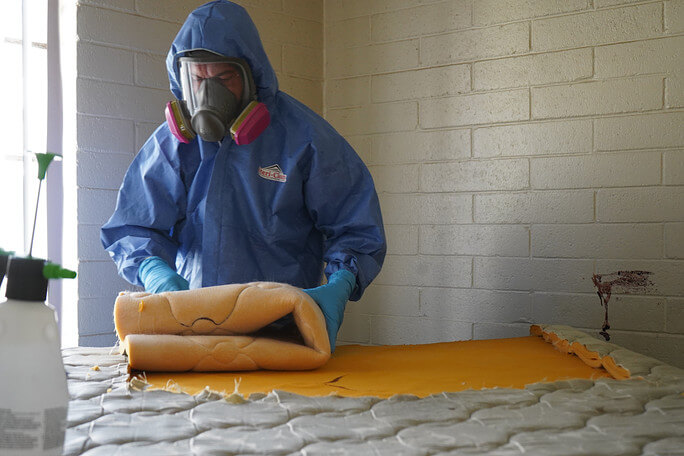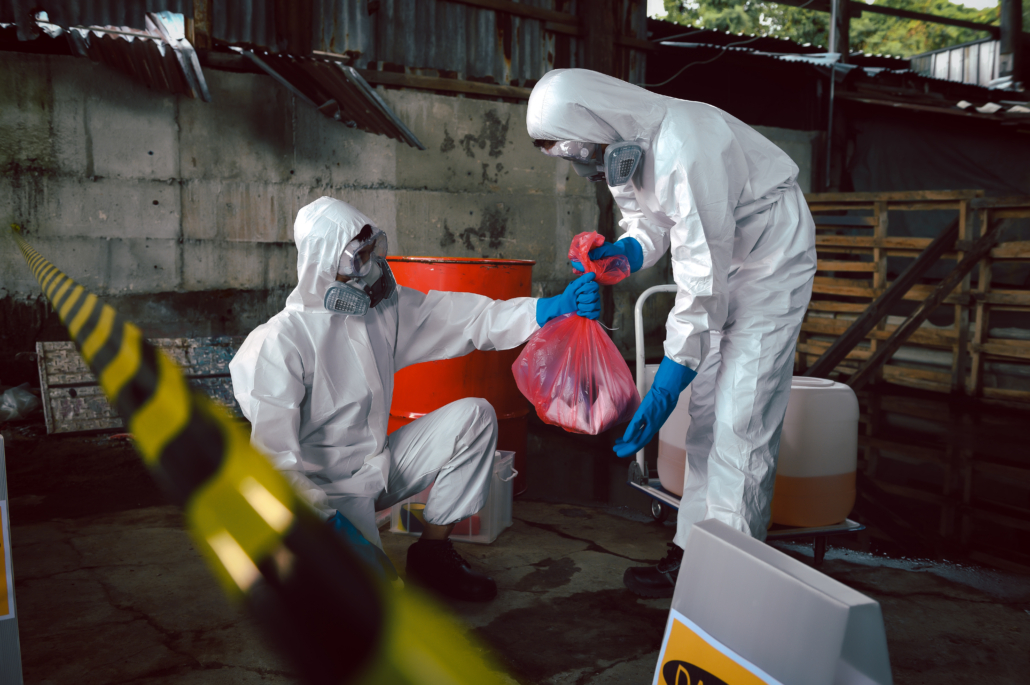Biohazard Removal: Safe Handling and Disposal of Hazardous Products
Biohazard Removal: Safe Handling and Disposal of Hazardous Products
Blog Article
Professional Biohazard Cleaning and Decontamination for Blood, Bodily Fluids, and Hazardous Materials
In the world of biohazard cleaning and decontamination for blood, bodily liquids, and hazardous materials, accuracy and proficiency are paramount. The possible wellness dangers connected with exposure to biohazards highlight the important requirement for thorough handling and thorough cleanup. Specialized training outfits experts with the understanding and skills needed to resolve these hazardous situations effectively. Nonetheless, it is not merely concerning cleaning up; the importance of using appropriate decontamination strategies can not be overstated. As we browse the elaborate landscape of biohazard cleanup, comprehending the subtleties of policies, conformity, and the customized equipment at play comes to be essential in ensuring a safe and comprehensive decontamination procedure.
Health Risks of Biohazard Direct Exposure
Direct exposure to biohazards poses considerable health and wellness risks that can cause extreme consequences for neighborhoods and individuals alike. Biohazards encompass a large variety of organic substances, including blood, bodily liquids, mold, microorganisms, infections, and various other possibly contagious products. When people come into contact with these biohazards, whether via accidents, improper handling, or ecological exposure, they face the danger of contracting significant illnesses or illness.
Among the main health dangers connected with biohazard exposure is the transmission of contagious conditions. Bloodborne virus such as HIV, liver disease B and C, and numerous microorganisms can be present in biohazardous materials, posturing a straight danger to human wellness. Inhaling airborne biohazards like mold and mildew spores or entering call with polluted surfaces can additionally bring about breathing concerns, allergic reactions, and various other damaging wellness results.
Moreover, biohazard exposure can have long-lasting health implications, with some conditions showing up years after the preliminary contact (Blood Cleanup). Therefore, it is crucial to focus on proper biohazard cleaning and decontamination to reduce these wellness risks and make sure the safety of people and communities

Specialized Training for Biohazard Cleanup
When it comes to handling biohazard cleaning efficiently and securely, specialized training plays an essential function in making certain proper purification treatments are complied with. Biohazard cleanup calls for details expertise and skills to efficiently reduce risks connected with bloodborne pathogens, bodily liquids, and hazardous products. Experts learnt biohazard clean-up go through rigorous direction on just how to securely deal with, eliminate, and get rid of biohazardous materials to avoid contamination and exposure.
Specialized training for biohazard cleanup covers a variety of essential topics, including appropriate personal protective devices (PPE) usage, bloodborne pathogen recognition, decontamination techniques, and contaminated materials disposal protocols. Individuals trained in biohazard cleaning are geared up with the required proficiency to assess contamination levels, identify prospective dangers, and execute appropriate cleaning treatments in conformity with regulatory criteria.
Constant training and education are extremely important in the field of biohazard cleanup to stay updated on the most recent purification modern technologies, safety and security protocols, and policies. By spending in specialized training, biohazard cleaning specialists can effectively react to emergency situation cleanup circumstances and safeguard both public wellness and the setting.
Relevance of Proper Decontamination Strategies
Making use of proper decontamination methods is crucial in biohazard cleanup to efficiently lessen and eliminate unsafe products wellness threats. Efficient purification not just makes sure the removal of visible traces of blood, bodily liquids, and other biohazards however additionally targets unseen microorganisms that may present significant health and wellness dangers otherwise correctly eradicated. By complying with stringent decontamination procedures, trained specialists can considerably decrease the threat of exposure to hazardous microbes, viruses, and germs that might result in infections or conditions.
Appropriate decontamination strategies involve making use of specialized devices and disinfectants that are especially designed to counteract biohazards effectively. Detailed cleaning and sanitation of infected locations are necessary to protect against the spread of microorganisms and make certain a risk-free atmosphere go now for residents. Furthermore, the proper disposal of biohazardous waste following decontamination procedures is important in avoiding contamination of various other surface areas or individuals.

Tools and Tools for Safe Cleaning
When dealing with blood, bodily fluids, or hazardous products, biohazard cleaning specialists rely on specialized gear to reduce exposure dangers and thoroughly decontaminate the damaged location. Additionally, biohazard cleaning sets containing anti-bacterials, absorbent materials, and biohazard bags are utilized to securely contain and get rid of of contaminated items.
Advanced cleansing devices like hospital-grade anti-bacterials, HEPA-filtered vacuums, and fogging devices are employed to sanitize surfaces and eliminate biohazards successfully. Specialized tools such as sharps containers and biohazard garbage disposal bins are used to safely take care of sharp objects and biohazardous waste products. By utilizing the ideal tools and devices, biohazard cleansing professionals can make certain a thorough cleanup procedure that prioritizes security and minimizes wellness threats for both workers and owners of the damaged room.
Laws and Conformity in Biohazard Cleaning
Proper adherence to guidelines and compliance standards is critical in biohazard cleaning to guarantee the security of both personnel and the atmosphere. Federal government firms such as OSHA (Occupational Safety and Health And Wellness Management) and the EPA (Environmental Defense Agency) have developed certain guidelines for biohazard cleaning treatments to reduce health and wellness risks and environmental contamination. These regulations cover a variety of aspects consisting of the handling, transport, and disposal of biohazardous products, in addition to the required training and safety equipment required for personnel included in the clean-up process.
Biohazard cleaning business must stay current with these policies to guarantee that their operations satisfy the called for safety and security requirements. Failing to comply with these policies can lead to serious repercussions, consisting of penalties, lawsuit, and threatening the health of individuals and the environment. By following strict guidelines and compliance actions, biohazard cleansing business can successfully minimize threats and ensure a complete and secure cleaning procedure for all parties entailed.
Final Thought
Finally, biohazard cleansing and purification require specific training, appropriate techniques, and adherence to guidelines. Exposure to blood, crime scene cleanup movies bodily liquids, and unsafe products presents significant wellness dangers, making it important to utilize the best equipment and tools for risk-free cleaning. By following rigorous methods and standards, professionals can efficiently reduce the dangers related to biohazard direct exposure and make sure the security of both themselves and others.
As we browse the intricate landscape of biohazard cleanup, recognizing the subtleties of policies, compliance, and the customized devices at play ends up being crucial in making certain a secure and thorough purification process. (Blood Cleanup)
When it comes to taking care of biohazard cleaning successfully and safely, specialized training plays an essential function in making certain correct purification procedures are complied with.Making use of correct purification techniques is critical in biohazard cleaning to properly eliminate harmful materials and reduce health and wellness why not find out more risks. Additionally, biohazard cleaning kits consisting of anti-bacterials, absorbent products, and biohazard bags are utilized to securely get rid of and contain of polluted products.
Government agencies such as OSHA (Occupational Safety And Security and Wellness Administration) and the EPA (Environmental Protection Agency) have actually developed certain guidelines for biohazard cleanup procedures to minimize health threats and environmental contamination.
Report this page